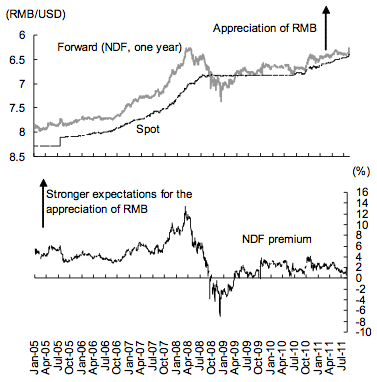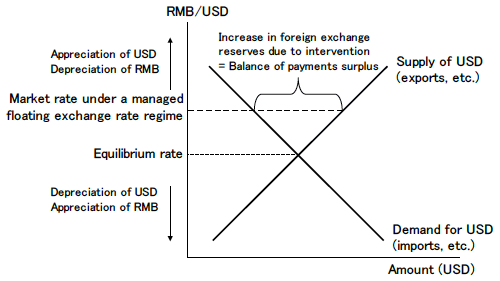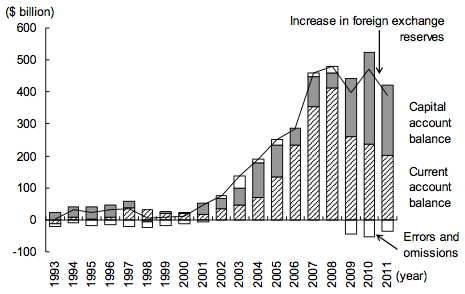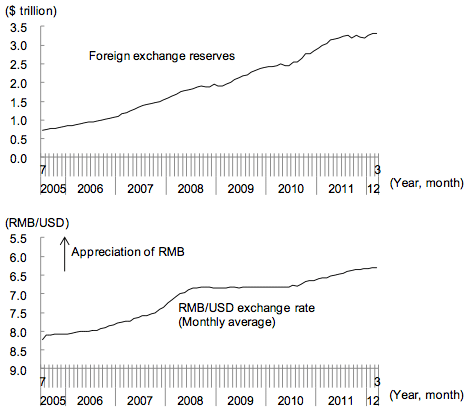When China made the shift to a managed floating exchange rate regime in July 2005 as the first step in its exchange rate system reform (renminbi reform), the renminbi (RMB) exchange rate was considered to be significantly below its equilibrium level. Since then, however, the RMB exchange rate has risen about 30% against the U.S. dollar (USD). Against this backdrop, not only has China's current account surplus declined substantially, but also the surplus in the balance of payments, which also includes the capital account, has almost been eliminated. The current RMB exchange rate, which has come to be set in the market with minimal intervention by the monetary authorities, seems to have approached its equilibrium level.
View of Premier Wen Jiabao
At the press conference on March 14, 2012, after the end of the fifth session of the 11th National People's Congress (NPC), Premier Wen Jiabao expressed his view that the RMB exchange rate was likely already close to its equilibrium level. He cited the following three points as the basis for this conclusion:
(1) In 2011, the ratio of China's current account surplus to its GDP fell to 2.8%, lower than the internationally recognized reasonable level of 3%.
(2) The real effective exchange rate of the RMB has already risen by 30% since the 2005 exchange rate system reform (Note).
(3) Fluctuations in the RMB in both upward and downward directions have been occurring in Hong Kong's non-deliverable forward (NDF) market since September 2011.
With respect to (1), the ratio of China's current account surplus to GDP has in fact fallen significantly from its peak of 10.1% in 2007. Regarding (2), the real effective exchange rate of the RMB has risen about 30%, almost the same as the rise in the RMB/USD exchange rate since July 2005 (according to the statistics of the Bank for International Settlements (BIS)). Regarding (3), the difference (NDF premium) between the NDF rate, which is used as an indicator for the expected future value of the RMB exchange rate, and the spot rate has almost been eliminated (Figure 1).
Figure 1: RMB/USD Exchange Rate - Spot vs. Forward (NDF) |
 |
| Source: Compiled by the author based on data from Bloomberg and the State Administration of Foreign Exchange of China. |
However, there is still doubt that one can come to the conclusion based on the points above that the RMB exchange rate is already close to its equilibrium level. First, in addition to the current account balance, the capital account balance also has to be considered as a factor in determining the exchange rate. Also, because the definition of "equilibrium level" is ambiguous, it is difficult to ascertain whether the difference between the current RMB exchange rate and the equilibrium level has been eliminated. Moreover, the NDF rate at present does not represent the equilibrium value in the market but only indicates a projection of the government's policy stance, given that it is set at the authorities' discretion rather than by the market.
Judgment based on market supply and demand
Let's examine here whether the current RMB exchange rate is at an equilibrium level, assuming that the equilibrium rate is determined solely by market supply and demand, as in the case of a freely floating exchange rate regime without intervention by monetary authorities.
Under a freely floating exchange rate regime, the exchange rate is determined entirely by market supply and demand (Figure 2). Demand for U.S. dollars (or foreign currencies in general), which is derived from imports as a current transaction and the outflow of funds as a capital transaction, declines as the dollar's exchange rate rises (a downward-sloping demand curve). On the other hand, the supply of dollars, which comes from exports as a current transaction and the inflow of funds as a capital transaction, increases as the dollar's exchange rate rises (an upward-sloping supply curve). The market rate is balanced at the level where supply and demand match each other. In addition, if the central bank does not intervene in the foreign exchange market, even if the current account balance is in surplus, this will be offset automatically by a deficit of the same amount in the capital account, so that foreign exchange reserves will not increase.
Figure 2: Equilibrium Rate Determined by Supply and Demand in the Market |
 |
| Source: Compiled by the author. |
However, under the current managed floating exchange rate regime, China's balance of payments, which combines the current account and the capital account balances, has been in surplus for a long time (Figure 3). This reflects the fact that the monetary authorities purchase the excess dollars in the market in the form of intervention, and foreign exchange reserves have risen sharply in this process. In particular, the continuous increase in China's foreign exchange reserves during the nearly two-year period following the collapse of Lehman Brothers when the RMB/USD exchange rate was stable clearly shows that market intervention had played an important role in stabilizing the exchange rate (Figure 4). However, China's foreign exchange reserves have not increased much since the fall of 2011, suggesting that the Chinese authorities have refrained from intervening in the market, and the current RMB exchange rate may have come close to its equilibrium level.
Figure 3: Growing Balance of Payments Surplus and Increasing Foreign Exchange Reserves in China |
 |
| Note: Increase in foreign exchange reserves = Current account balance + Capital account balance + Errors and omissions. |
| Source: Compiled by the author based on data from the CEIC Database. |
Figure 4: Change in China's Foreign Exchange Reserves and the RMB/USD Exchange Rate |
 |
| Note: The foreign exchange reserves in January and February 2012 are estimates. |
| Source: Compiled by the author based on data from the CEIC Database. |
Favorable opportunity to transit to a freely floating exchange rate regime
Since July 2005, China has been seeking to move from a fixed exchange rate regime to a floating one as part of its RMB reform. In this process, the monetary authorities have tried to limit the pace of the appreciation of the RMB exchange rate through market intervention in order to prevent China's international competitiveness from declining sharply. If the RMB exchange rate has already reached its equilibrium level, it is unlikely to rise sharply even if the authorities refrain from intervening in the market. Therefore, we could say that the time is ripe for China to make the transition to a freely floating exchange rate regime. In fact, the intra-day trading band for the RMB exchange rate was expanded on April 16, 2012 from +/-0.5% to +/-1.0% around its central parity rate set by the authorities on each trading day. It is expected that, in the wake of this, the pace of transition to a freely floating exchange rate regime will be accelerated.


